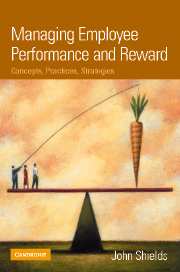Book contents
- Frontmatter
- Contents
- List of figures and tables
- Foreword by John Egan
- Acknowledgements
- Introduction: Setting the scene
- Part 1 The fundamentals
- Part 2 Performance management in action
- Part 3 Base pay and benefits
- Part 4 Rewarding employee performance
- 14 Overview of performance-related rewards
- 15 Merit pay for individual performance
- 16 Recognition awards
- 17 Results-based individual incentives
- 18 Collective short-term incentives
- 19 Collective long-term incentives
- 20 Executive incentives
- Case study. Beyond the hard sell: Performance incentives at Southbank
- Part 5 Fitting it all together
- Model responses to case studies
- References
- Index
15 - Merit pay for individual performance
from Part 4 - Rewarding employee performance
- Frontmatter
- Contents
- List of figures and tables
- Foreword by John Egan
- Acknowledgements
- Introduction: Setting the scene
- Part 1 The fundamentals
- Part 2 Performance management in action
- Part 3 Base pay and benefits
- Part 4 Rewarding employee performance
- 14 Overview of performance-related rewards
- 15 Merit pay for individual performance
- 16 Recognition awards
- 17 Results-based individual incentives
- 18 Collective short-term incentives
- 19 Collective long-term incentives
- 20 Executive incentives
- Case study. Beyond the hard sell: Performance incentives at Southbank
- Part 5 Fitting it all together
- Model responses to case studies
- References
- Index
Summary
Merit pay is the most widely applied of the individual performance pay plans, and it takes two main forms: merit increments and merit bonuses. With merit increments – also known as merit raises – each employee typically receives an increase in base pay based on their annual performance assessment ranking or rating. These payments are referred to as merit raises or merit increments because they take the form of a permanent addition to base pay. By contrast, merit bonuses take the form of stand-alone payments that do not flow into the individual's base pay and must be re-earned each performance round. In this chapter, we examine each of these two variants of merit pay, beginning with merit increment plans, which are the more traditional of the two.
Merit increments
In a typical traditional merit pay system, merit payments are delivered in the form of cumulative annual increments to the individual's base pay. The practice rewards employees for performance in a previous time period – typically one year – and, once given, each merit increment is ‘folded’ into base pay. In the USA and many other Western countries, annual merit increments still constitute the main form of regular base pay adjustment.
There are two distinct approaches to linking assessed performance to merit increments: (1) straight increments and (2) the merit grid approach.
Straight increments
The straight increments option involves paying all employees who fall within the same performance grade an equal increment.
- Type
- Chapter
- Information
- Managing Employee Performance and RewardConcepts, Practices, Strategies, pp. 369 - 386Publisher: Cambridge University PressPrint publication year: 2007



